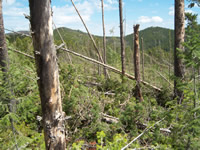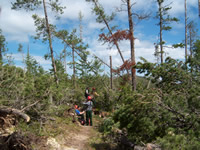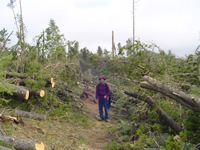Forests and Rangelands Success Story
Judith Mountains - Limekiln Trail Blow-down
Montana
National Fire Plan - Fuels Reduction
2008

Photo 1: A portion of the area which was heavily impacted by the wind event.

Photo 2: A freshly cleared area of the Limekiln Trail. The scale of fire crew members provides a reference scale for the depth of the wind-thrown trees.

Photo 3: A portion of the Limekiln Trail that was cleared. Much of the material in the blow-down could be salvaged.
In spring of 2008, a localized wind event, along with saturated soils, created about 200 acres of heavy blow-down of dense lodge pole pine and Douglas fir stands in the Judith Mountains of central Montana. Smaller pockets of blow-down were scattered throughout the greater area to encompass about 600 total acres. About 130 acres of state lands (Montana Department of Natural Resources or DNRC) were affected by the blow-down. Photo 1 shows a portion of the heavily impacted area.
The resulting fuel bed in the heavily impacted area was estimated to be continuous, at a depth of five to six feet, in many places. Photo 2 indicates the depth of the wind-thrown trees. Reconnaissance work indicates about 1.5 million board feet of timber directly impacted by the wind event, and up to 1.5 million board feet affected by peripheral wind damage and other forest health issues. Photo 3 indicates the potential salvage possibilities. Portions of the Limekiln recreational trail system have become impassable, and were temporarily rerouted by the Bureau of Land Management (BLM) fire crew.
The BLM and DNRC have jointly drafted a proposed action and presented it to the public. The consensus is to treat the area as soon as possible while there is still value in the logs. Most concerns include whether to leave or rehabilitate areas with weeds, post-logging condition of county roads, and future treatment of the BLM roads.
A Snapshot update about this project will be published next summer.